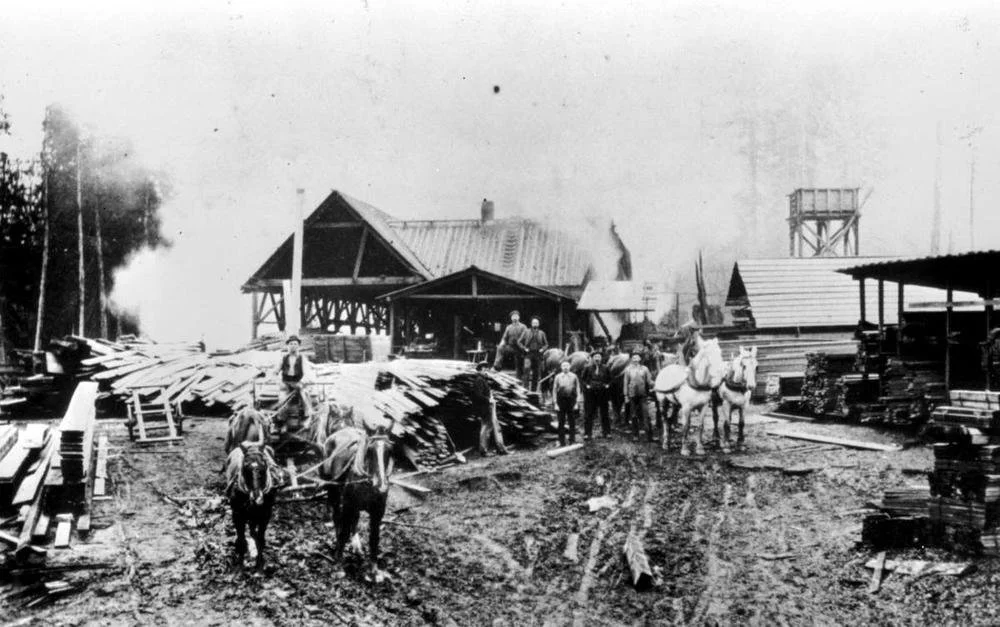Editorially speaking…
I knew it was too good to last. In fact, I’m amazed that it lasted this long.
I’m referring to a singular piece of real estate, the site of a 1920s sawmill beside the Island Highway at the entrance to Lantzville.
Jennifer and I visited it several times, and a minor gold mine it was for Chinese and Japanese bottles, crockery and various other artifacts.
It probably looked much like this Coburn mill, complete with horses as we found rotted harness and a hame. —BC Archives
What makes this site remarkable, other than it has been logged at least twice, is that it’s pretty much as it was after the sawmill, workers’ houses and outbuildings were demolished a century or so ago.
Imagine that, left untouched for a century, complete with a beautiful waterfall and one of the largest anthills I’ve ever seen.
But not, alas, for much longer if plans for yet another shopping centre bear fruit.
Sigh....
* * * * *
Nanaimo’s darned abandoned coal mines are at it again, collapsing roadways.
The latest is an expensive sinkhole in Westwood Road. Expensive because the only way to deal with sinkholes is to pour in yards of concrete and gravel—once you’ve determined bedrock.
Wouldn’t you think those fool coal miners would have had more sense than to dig their tunnels underneath downtown Nanaimo, shown here in 1910. —BC Archives
I wonder if, before roads crews go to work, anyone ever sends down a probe to see if anything of the mine is detectable.
It’s local legend that when they were building the Expressway they exposed a complete underground stable, still intact. They couldn’t cover it up fast enough lest any historic busybodies held up work.
* * * * *
Here’s a headline I never thought I’d see: Canada has most measles cases in North and South America.
Measles, sad to say, is back with a vengeance because of, it appears, non-vaccinations by parents.
Anyone who has ever toured cemeteries will have been struck by the number of children’s graves. Why? Because, in the world before the miracles of modern medicine, childhood mortality was something like 50 per cent.
Think about that. Maybe not in rich families that ate and lived well, but for po’ folk, infant and childhood mortality was a sad reality. It was common to use a Christian name more than once in the same family—when the first William died, the name was given to a later child.
Then came vaccinations and inoculations and everything changed. Until lately.
* * * * *
Here’s another interesting twist on history. Canada is shopping for new submarines—in Germany.
The German submarine U-190 upon surrender to the RCN in St. John’s Nfld., in May 1945. —Wikipedia
How ironic! In both world wars German U-boats were the scourge of the seas, claiming more Allied ships than any other armed service. HMCS Esquimalt, the last Canadian warship to be lost in the Second World War, was torpedoed with great loss of life in Canadian home waters.
That particular submarine, the U-190, then served for a time in the Royal Canadian Navy for training purposes until consigned, almost symbolically, to the deep by gunfire.
So here we are, 80 years later, looking at buying German submarines.
* * * * *
That’s not the only historical flip-flop for the RCN. Corvettes, the small, inexpensive and highly efficient anti-submarine vessels during the last war, may be coming back. For three-quarters of a century and more, we’ve relied on frigates and destroyers, both of them larger and more expensive than corvettes.
Which is precisely why corvettes may be coming back as the navy’s looking for ships “with a long range that pack a punch in combat and can also deal with Arctic ice”.
If you’ve ever seen winter photos of the famous North Atlantic convoys you’ll know that the tough little corvettes, built to the design of a deep-sea trawler, were capable of dealing with ice!
* * * * *



